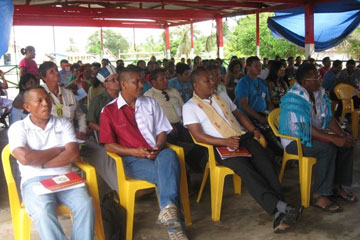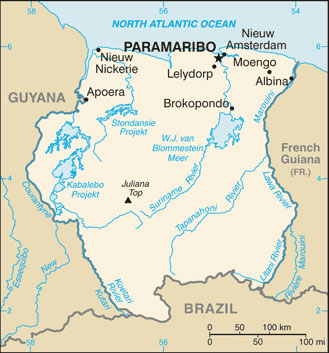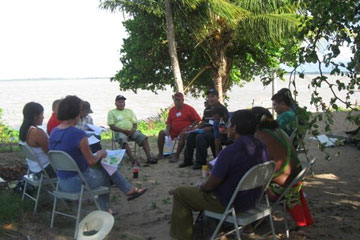Aerial view of Kwamala village in the interior of Suriname. Photo by: Rhett A. Butler.
Legal rights and recognition for the diverse indigenous peoples of Suriname have lagged behind those in other South American countries. Despite pressure from the UN and binding judgments by the Inter-American Court of Human Rights, Suriname has yet to recognize indigenous and tribal land rights, a situation that has disconnected local communities from decisions regarding the land they have inhabited for centuries and in some cases millennia. A new report, Securing Indigenous Peoples’ Rights in Conservation in Suriname: A Review outlines how this lack of rights has alienated indigenous communities from conservation efforts in Suriname. Instead of having an active say in the creation of conservation reserves, as well as their management, decisions on indigenous lands have traditionally been imposed from the ‘top-down’ either by government officials or NGOs.
According to the Association of Indigenous Village Leaders in Suriname (VIDS), this lack of legal recognition of land rights is the biggest threat to indigenous communities in Suriname.
The lack of legal recognition “allows individuals, companies and NGOs (including ‘environment’ NGOs) to ask and get land titles in indigenous territory and undertake various kinds of destructive or disruptive activities such as mining, logging, sand extraction, building infrastructure, etc. without the consent of the affected communities, and disrupting ecosystems and social and cultural patterns,” VIDS told mongabay.com.
 VIDS meeting. Photo courtesy of VIDS. |
Dominiek Plouvier, Regional Representative of World Wide Fund for Nature (WWF)-Guianas, which includes Suriname, says that part of reason Suriname land rights still haven’t been settled is because Suriname is a young nation (it became independent of the Netherlands in 1975) whereas other countries in South America go back hundreds of years.
A further complication in Suriname is the issue of maroons: descendants of escaped West African slaves, who have formed distinct tribal groups and are also fighting for land rights. According to Plouvier, maroons make up one-fifth of the population in Suriname, while Amerindians make up just 3-4 percent. WWF is currently advocating for the government of Suriname to work with indigenous people and maroons in establishing land rights.
According to VIDS, though, stagnation is largely due to politicians. There is a ” limited degree of awareness about [indigenous peoples’] rights on the side of politicians who have always been relatively narrow-minded in terms of international scope,” and, the group adds, Suriname politicians are largely focused on the US, the Netherlands, and more recently the Caribbean, instead of their South American neighbors where indigenous rights’ movements are stronger.
A number of other components have also stalled legal rights recognition in Suriname, says VIDS. For example, the tiny country is relatively isolated as the only Dutch-speaking nation in South America.
“A language which in itself is not native to the indigenous peoples so international information in English or Spanish is rather inaccessible and the relative late ‘arrival’ of telecommunication in Suriname in general and in the interior in particular,” says VIDS.
In addition, subsequent governments have simply continued with the historic marginalization of indigenous peoples in Suriname, and outside pressure for change hasn’t been very forthcoming. As VIDS explains, Suriname is not deemed a “sexy” country for outside governments or donors to get involved with.
 Map of Suriname. Photo courtesy of the CIA. |
Suriname is a tiny country along the northern coast of South America. All its populous cities rest along the thin coastal line in the north, while a vast and mostly-pristine rainforest interior covers much of the sparsely populated south. Indigenous groups, which largely inhabit the nation’s south or ‘interior’, include the Arawak, Trio, Wayana, Carib, and the Akuriyo.
But there may be a final reason land rights are still on the backburner. As in many parts of the world, such rights directly conflict with the government’s desire for industrial development.
“In Suriname, land rights are always connected with development (especially mining), that’s the problem,” Gwen Emanuels-Smith from the Amazon Conservation Team (ACT), a US-based NGO that works with indigenous groups in Suriname and other South American countries told mongabay.com. “Government has a very westernized concept of development which is very different from the tribes, which have difficulty getting their land rights issues on the table.”
Despite such difficulties, things may be finally changing. Signs point to Suriname’s new government under President Desi Bouterse—elected in 2010—taking an interest in finally tackling the thorny problem. Having been moved from the ministerial to the cabinet level, it has become “a high priority issue” says Emanuels-Smith.
While VIDS agrees that the issue has taken on new importance, the organization has yet to see the government act in the way its members hope.
“Good intentions have been expressed, informally as well as formally in the official Government’s Declaration and in various speeches of the president, in which it was mentioned that the land rights’ issue ‘will be solved’ and that indigenous peoples will get ‘positive discrimination’ (in terms of development opportunities) but it is yet unclear how this will be materialized,” says VIDS.
In October the Suriname government has scheduled a conference that will bring stakeholders together with hopes to hash out a solution on land rights with the help of an independent mediator.
“We hope to effectively participate in such policy-making and programming in order to avoid ‘solutions’ that are top-down and not in line with our rights, priorities and perspectives, says VIDS.
However, part of the problem may be that the government and some conservation groups see VIDS as asking for too much. VIDS currently is pushing for “full ownership and management rights” in the nation’s protected areas. Part of this would include free prior and informed consent (known as FPIC) before conservation or development occurs on such lands. While Emanuels-Smith of ACT, says that while such standards are important today, one cannot expect to apply such measures to past actions and ongoing blame does not help.
|
Indigenous park guard on forest patrol in Suriname. Photo by: Rhett A. Butler. |
“There was no concept of FPIC back when conservation was established in Suriname… we can’t go back and change that. Now we live in a different time and we have to have different ways of doing development based on lessons learned from the past. FPIC is now part of that process.”
In other words the past—even if unjust—is still past, and indigenous groups will do better in Suriname if they keep their eye on the future.
Plouvier with WWF says that compromise will be necessary to break any impasse, but there are models worldwide that have succeeded in allowing indigenous groups significant management over their lands, while retaining official conservation statuses, and not wholly alienating governments and NGOs.
“In other parts of the world, governments and indigenous peoples have resolved these historical problems by negotiating agreements for co-management [in protected area], and changes to protected areas policies that enable indigenous and community conserved areas. In this way, indigenous rights and the conservation status of these areas (often also of interest and concern to indigenous peoples) can both be addressed.”
Plouvier adds that WWF has worked with both indigenous communities and the Suriname government on how this ‘new paradigm’ has worked abroad.
Worldwide conservation and indigenous rights are evolving rapidly, especially as climate change comes more and more into play. For example, a new UN-sponsored program dubbed Reduced Emissions from Deforestation and Forest Degradation (REDD+) plans to pay nations to keep forest standing as long-term carbon sequestration instead of felling them for short-term profit. If REDD succeeds it could be a game changer in how forests, including indigenous forests, are preserved. But like many others in the indigenous community, VIDS has considerable concerns related to REDD.
|
Trio shaman in Suriname. Photo by: Rhett A. Butler. |
“Currently, we do not see a future for REDD+ in Suriname, at least not one that is characterized by a real sustainable development vision, unanimous support and respecting human rights in particular indigenous and tribal peoples’ rights,” VIDS says.
VIDS fears that REDD+ could make it harder to secure land rights, including further restricting land use, and possible restrictions on rotational agriculture that is practiced by a number of indigenous groups.
“We categorically reject the notion of the traditional rotational agriculture to be one of the causes of deforestation. It is rather disturbing that this is mentioned as a cause of deforestation while the big drivers of deforestation in Suriname, which Suriname is not likely to change, are mining and infrastructure,” says VIDS, who refers to REDD+ as a possible ‘time bomb’ for indigenous peoples.
However, since payments through REDD+ are based on declines in deforestation rate, the program will likely not be as big of a player in Suriname as in other South American countries since Suriname has a low deforestation rate.
Still indigenous people in Suriname have seen little real aid, or understanding, from big foreign entities, which may be one reason why REDD+ does not sit well.
For example, VIDS feels the International Development Bank (IDB) does not sufficiently respect indigenous’ rights and interests, works top-down and offers little participation in their country’s program and projects.
“Even projects that are supposedly focusing on the [Suriname] Interior are benefiting government or city-based organizations/consultants [and not indigenous communities],” says VIDS. “An example was the Support for the Development of the Interior (SSDI) project financed by the IDB involving approximately $750,000 for studies on land rights and on development planning for the Interior, spent on city-based consultants, including ACT, who didn’t bother to have real consultations with us (a superficial discussion or one-time workshop we do not consider a consultation) and made recommendations that run counter to our rights.”
 Another VIDS meeting. Photo courtesy of VIDS. |
However Emanuels-Smith says that VIDS decided not to participate in the IDB project: “VIDS officially [withdrew] from the project while ALL other tribes have participated. The reason is that they are not agreeing with the methodology, they wanted to do it themselves.”
Another IDB project that resulted in further marginalization of Suriname indigenous groups according to VIDS is a school program that benefited city-based education, leaving children of the interior largely ignored.
VIDS sees achieving land rights as a vital way to counter such top-down decisions and gain a long-sought seat at the table.
Of course even if the indigenous groups in Suriname are able to win land rights, this does not mean such issues will be over. In many parts of the world, governments and private corporations have still steamrolled over indigenous groups, even when those groups hold the deed to the land. Free and prior consent may be claimed by many at the top, but is rarely practiced with the satisfaction of the indigenous groups involved.
In order to prepare themselves to face such situations—which have ended violently and tragically in other countries—Emanuels-Smith says indigenous groups need to establish a long-term vision for how they want their future to look.
“Tribes need to prepare themselves to be ready for development. If you are just on the sidelines yelling ‘this isn’t good’ without seeking solutions, they are going to lose out. Tribes need to prepare themselves. Once they have land rights. What does development mean in their eyes? How do they do benefit sharing? How do they manage lands? What is their plan? This needs to be discussed now. Blindly opposing everything doesn’t yield solutions,” she says.
Indigenous settlement from the air in Suriname. Photo by: Rhett A. Butler.
Related articles
Biologists warn of rainforest mining threat from Alcoa, Newmont in Suriname
(02/23/2009) A prominent group of biologists are calling for Alcoa, Newmont Mining Corp, and other minerals conglomerates to forgo gold and bauxite mining operations in a biologically-rich zone in the South American country of Suriname.
An interview a shaman in the Amazon rainforest

(07/28/2008) Deep in the Suriname rainforest, an innovative conservation group is working with indigenous tribes to protect their forest home and culture using traditional knowledge combined with cutting-edge technology. The Amazon Conservation Team (ACT) is partnering with the Trio, an Amerindian group that lives in the remote Suriname-Brazil border area of South America, to develop programs to protect their forest home from illegal gold miners and encroachment, improve village health, and strengthen cultural ties between indigenous youths and elders at a time when such cultures are disappearing even faster than rainforests. In June 2008 mongabay.com visited the community of Kwamalasamutu in Suriname to see ACT’s programs in action. During the visit, Amasina, a Trio shaman who works with ACT, answered some questions about his role as a traditional healer in the village.
Scientists call for mining ban, new protected areas in Suriname
(06/20/2008) In a resolution set forth at their annual meeting in Paramaribo, Suriname, the largest group of tropical biologists called upon the Surinamese government to evict informal gold miners from three ecologically important areas in the South American country. Miners have been blamed for a number of environmental problems including over-hunting of wildlife, deforestation and destruction of riparian habitats, erosion, and mercury pollution in waterways.














